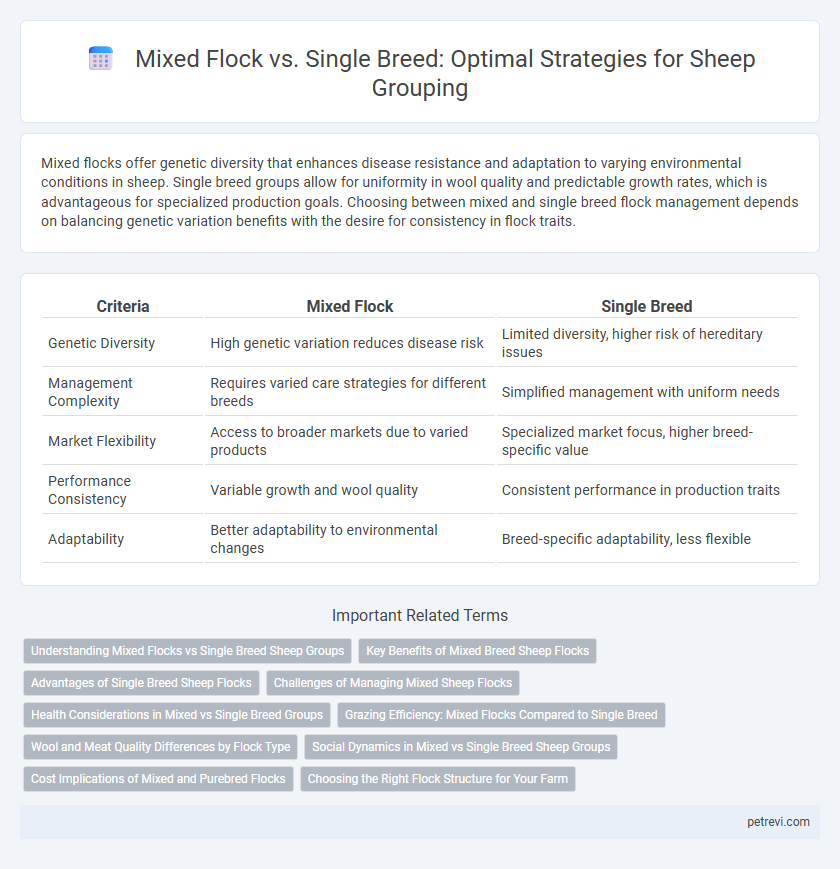Mixed flocks offer genetic diversity that enhances disease resistance and adaptation to varying environmental conditions in sheep. Single breed groups allow for uniformity in wool quality and predictable growth rates, which is advantageous for specialized production goals. Choosing between mixed and single breed flock management depends on balancing genetic variation benefits with the desire for consistency in flock traits.
Table of Comparison
| Criteria | Mixed Flock | Single Breed |
|---|---|---|
| Genetic Diversity | High genetic variation reduces disease risk | Limited diversity, higher risk of hereditary issues |
| Management Complexity | Requires varied care strategies for different breeds | Simplified management with uniform needs |
| Market Flexibility | Access to broader markets due to varied products | Specialized market focus, higher breed-specific value |
| Performance Consistency | Variable growth and wool quality | Consistent performance in production traits |
| Adaptability | Better adaptability to environmental changes | Breed-specific adaptability, less flexible |
Understanding Mixed Flocks vs Single Breed Sheep Groups
Mixed flocks combine various sheep breeds, enhancing genetic diversity and resilience against diseases while optimizing pasture usage through different grazing habits. Single breed groups allow for uniformity in wool quality, meat production, and easier management of breed-specific health issues, ideal for specialized farming goals. Balancing the benefits of mixed versus single breed flocks depends on farm objectives such as productivity, disease control, and market demands.
Key Benefits of Mixed Breed Sheep Flocks
Mixed breed sheep flocks offer enhanced genetic diversity, leading to improved disease resistance and adaptability to varying environmental conditions. This diversity often results in higher overall flock productivity through complementary traits such as better wool quality and increased meat yield. Farmers benefit from a more resilient and economically stable flock by mixing breeds with different strengths and reproductive rates.
Advantages of Single Breed Sheep Flocks
Single breed sheep flocks offer consistent genetics, which enhance uniformity in wool quality, growth rates, and disease resistance, facilitating targeted breeding programs. Managing a single breed simplifies health protocols and nutritional requirements, reducing operational complexity and costs. This uniformity supports more predictable market outcomes and specialized product branding, increasing profitability for sheep producers.
Challenges of Managing Mixed Sheep Flocks
Managing mixed sheep flocks presents challenges such as varied nutritional requirements and differing disease susceptibility, complicating feeding and health protocols. Behavioral differences among breeds can lead to increased stress and competition for resources. Moreover, mixed flocks demand more careful breeding management to maintain genetic diversity and flock uniformity.
Health Considerations in Mixed vs Single Breed Groups
Mixed flock sheep often benefit from reduced parasite transmission due to varied immune responses across breeds, lowering disease spread compared to single breed groups. Single breed flocks face higher risks of genetic vulnerability to specific diseases, which can lead to more severe outbreak impacts. Health management requires tailored strategies in mixed groups to address breed-specific needs while single breed flocks demand rigorous biosecurity measures to prevent homogeneous disease susceptibility.
Grazing Efficiency: Mixed Flocks Compared to Single Breed
Mixed flocks enhance grazing efficiency by combining breeds with complementary foraging behaviors, allowing more effective utilization of available pasture. Diverse dietary preferences reduce vegetation overlap and soil compaction, leading to improved pasture health and sustained forage availability. Single-breed groups often result in uniform grazing patterns that can cause overgrazing and uneven nutrient distribution in the grazing area.
Wool and Meat Quality Differences by Flock Type
Mixed flocks of sheep often provide a diverse range of wool textures and meat flavors due to the genetic variability from multiple breeds, enhancing overall market appeal. Single breed flocks typically produce more uniform wool fiber diameter, staple length, and consistent carcass quality, benefiting specialized producers targeting niche markets. Wool quality in mixed flocks varies with breed composition, while meat quality differences hinge on breed-specific traits such as marbling, tenderness, and growth rate.
Social Dynamics in Mixed vs Single Breed Sheep Groups
Sheep in mixed flocks exhibit more complex social dynamics compared to single breed groups, as variation in temperament, size, and activity levels influences dominance hierarchies and cohesion. Single breed sheep tend to establish more stable social structures due to uniform behavioral traits and physical characteristics, facilitating predictable interactions. Understanding these social dynamics is crucial for optimizing welfare and management practices by reducing stress and promoting harmonious group behavior.
Cost Implications of Mixed and Purebred Flocks
Mixed flocks often reduce overall feed and management costs by leveraging breed-specific strengths, improving pasture utilization and lowering veterinary expenses through enhanced disease resistance. Purebred flocks typically incur higher costs due to specialized feeding requirements, targeted healthcare, and the need for controlled breeding programs to maintain genetic purity. Evaluating these cost implications helps optimize profitability by balancing operational expenses with production goals in sheep farming.
Choosing the Right Flock Structure for Your Farm
Mixed flocks offer genetic diversity that can enhance disease resistance and pasture utilization, while single breed flocks provide uniformity in growth rates and product quality, making management more predictable. Choosing the right flock structure depends on your farm's goals, whether prioritizing market niche specialization with purebreds or adaptability through mixed breeds like Dorset, Suffolk, and Katahdin. Evaluating local climate conditions, feed resources, and consumer demands ensures optimal productivity and profitability in your sheep farming operation.
Mixed Flock vs Single Breed for Sheep Grouping Infographic

 petrevi.com
petrevi.com